
Other stories of early traders in East Griqualand
The McGinns
Other East Griqualand trade tokens and
collections
There is no other region like Nomansland/East Griqualand in South Africa so rich in early trade token coins (ie pre-1910). The small town of Montagu, near Cape Town, comes a distant second. Their tokens and bank notes can be seen at this link.
[1815/16 Griqua Town "coins"]
[1860: Durban Club 6d] [1862 Durban
Bank £5 Bank Note] [1868: Griqua £1 Bank
Note]
[1874: Mount Currie Express Stamp]
[1874/1932: Strachan and Co Currency Tokens]
[1876 Pietermaritzburg Franklin Penny]
[Other E Griqualand Tokens]
[1870s Griqua Town Patterns] [1890:
Griqua Patterns] [Other Serious Griqua Coin
Collectors]
[The History of the Griqua People]
[Griqua Token Coins, Coins and Bank Notes]
[Web Site Text Site Map]
[Tokencoins.com Home Page]
[Other South African Metal Token Coins]
 Strachan
and Co
Strachan
and Co
The Strachan and Co trade tokens are the best researched and most sought after South African trade tokens by numismatists and serious coin collectors and investors. They were until recently known as "South Africa's forgotten currency" but that title is now outdated as they are now widely accepted as part of the country's early numismatic history. The coins were widely used as currency for over 50 years (1874 - 1932) in Nomansland/East Griqualand, the once remote and isolated region bounded by the Drakensberg to the west, the Umzimkulu river to the north, the sea to the east and the Cape Colony to the south. They are, in fact, as numismatically important as the early Burgerspond (1874), Veld Pond (1902) and Kruger (1892 - 1900) pieces despite the fact that they were produced by a trading store for general use in a remote region of the country. Location of Strachan's stores can be seen at this link. The Strachan and Co trade tokens were first issued in the same year (1874) as the rare Mount Currie Express one penny stamp.
In C L Engelbrecht's 1987 excellent work, "Money in South Africa" he dedicates a chapter (pp129-130) to the role of token coins in overcoming the scarcity of small change in South Africa and writes, "The token money with the longest and perhaps the most interesting history is that of the Strachan and Co... In this isolated part of South Africa, the need for small change presently made itself felt. Change was very scarce indeed, and in Natal, the main source of supply for the business, it was practically unobtainable".
A coin from each of the four different sets:
The value of these sets has climbed dramatically over the past five years
- outstripping the investment value of any other coin in South Africa during
this period. These values are set to rise still further as more serious
numismatists seek out one of the small numbers of sets in existence and available
to them.
The last price paid for a complete set was US$3,500 in 2005. Strachan and Co sets very rarely come onto the market. Most sets area accounted for and a directory of known owners is documented on this web site. The rarest set is the "MH" or Mountain Home numbering about 100 in each denomination, while the most common is the fourth set, the new "In Goods" set of which there are thousands of each denomination in existence - making this unique numismatic set. You can find out more about the Strachan and Co trade tokens at this link.
The last set sold was in 2005. No known complete sets of Strachan and Co
are currently available for sale in the world today. |
 |
Only known example (Fuld) Rarity Scale: R -10).
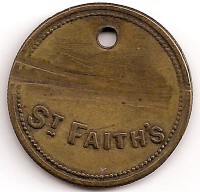 |
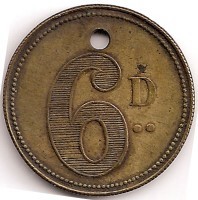 |
The only St Faith's token known, issued in the 1890s by John Royston who would later gain military fame and the unique name "Galloping Jack".
The value of this unique token is estimated at over US$5,000.
Milner Snell the Curator of the Kokstad Museum notes that his grandfather managed the Brooklands store (see Creighton and Dennis below) for Strachan and Company in the 1940s near St. Faiths. He often spoke about a Mr R.R. Hill who owned the St faith's store for many years. The store was originally established in the 1890s by John Robinson Royston on his farm St Faith. Royston who made a name for himself as a skilled and brave soldier.
William Royston and his cousin Joseph Royston immigrated to South Africa together bringing their wives and first born with them from the UK. John Robinson Royston (Galloping Jack) was the 7th child of William Royston.
There are references to (Galloping Jack) Royston having a farm surveyed at St faith's in 1893. Royston, known as Zithulele (the silent one), ran away from school at the age of fifteen and fought in the Anglo-Zulu War. During the Anglo-Boer War he was involved in the siege of Ladysmith. He received the D.S.O. in 1902 and was appointed C.M.G. in 1903. After the Anglo-Boer War he went back to farming but this time in the Port Shepstone area. The store at St Faith's, in southern Natal near the Umzimkhulu River, was looked after by managers. The fearless Royston obtained the nickname 'Galloping Jack' during the Palestine campaign by riding up and down the lines shouting 'No surrender' while six horses were shot from under him. During the First World War Royston was the Commanding Officer of the 12th Light Horse Regiment.
The images below were taken by Paul Baxter on St Faiths Road in December 2009 (More at this link)
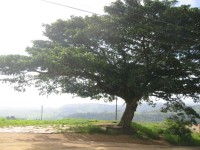 |
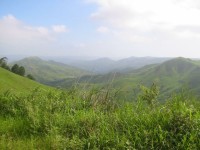 |
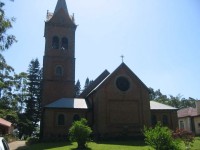 |
| The foundations under the tree are all that remain of the old store | The scenic road to St Faiths | The Maristella Church on St Faiths Road |
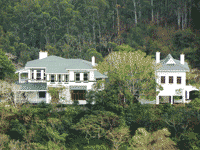 Royston Hall (seen right), where John Royston lived, is situated just eight minutes from Port Shepstone on an elevated site of 5,9 hectares fronting onto the Umzimkulu River. The gracious manor house is today a national monument and the land classified as conservation reserve.
His manor house comprises three spacious bedrooms with wooden floors, large lounge, dining room, wooden winding staircase, library, covered veranda and old style kitchen fitted with modern equipment and cupboards. Adjacent is a large cottage with bedroom, lounge, kitchen, offices and boardroom. The land has indigenous vegetation with small animal life such as mongoose, small buck and duiker as well as considerable birdlife.
Royston Hall (seen right), where John Royston lived, is situated just eight minutes from Port Shepstone on an elevated site of 5,9 hectares fronting onto the Umzimkulu River. The gracious manor house is today a national monument and the land classified as conservation reserve.
His manor house comprises three spacious bedrooms with wooden floors, large lounge, dining room, wooden winding staircase, library, covered veranda and old style kitchen fitted with modern equipment and cupboards. Adjacent is a large cottage with bedroom, lounge, kitchen, offices and boardroom. The land has indigenous vegetation with small animal life such as mongoose, small buck and duiker as well as considerable birdlife.
His life story is told in a book entitled 'Galloping Jack' by Napier Devitt. The Balson Holdings Family Trust hold a copy of this extremely rare book signed by the author.
More can be seen about his illustrious military career at this link . Royston's volunteer regiment, Royston's Horse, was established in Natal in 1906 to help quell growing rebellion among the Zulu tribes. The volunteer group of 500 horsemen faced severe fighting in Zululand but was disbaned in August 1906 after about five months when the rebellion was defeated. More at this link
In the early 1920s Royston leased the St faith's store to Ronald Reuben Hill. Hill spent 24 years at St Faith's. In about 1937 he bought the store from Royston. The store was registered as belonging to RR Hill and Company. Hill was at St Faith's in 1946 but sold the shop to Collins and Boffa in 1947. Hill worked for the Native Affairs Department in Durban until his death in 1970. Hill was born in Qumbu in East Griqualand and worked as a shopkeeper in Matatiele.
Only known example (Fuld) Rarity Scale: R -10).
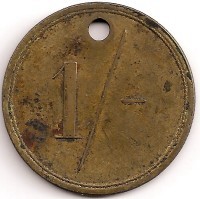 |
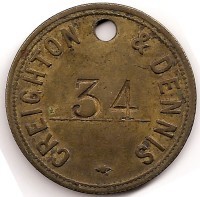 |
This is the only token of its kind known today.
The value of this token estimated at about US$5,000.
Very little is known about the company Creighton and Dennis. It seems that it was a business run by H.J. Creighton and E.E. Dennis. Edward Ernest Dennis was born in England. From 1906 until approximately 1910 he was a storekeeper on the farm Finchley in the Ixopo area. By 1912 Dennis owned the Brooklands trading store in the Highflats area of Ixopo. The Brooklands store site included a butchery and bakery and was on the road from Highflats to Port Shepstone. On 18 September 1912 Dennis married Bertha Jane, the daughter of James Gold. In 1918 Dennis sold Brooklands for £1,500 to Strachan & Co. of Umzimkulu. A year earlier Strachan & Co. had bought two stores belonging to H.J. Creighton in the same area. Strachan & Co. owned the Brooklands store until 1980 when it was sold to a Mr Goba.
There are no references to Creighton and Dennis on the database of the Natal Archives. This is unusual as if they had entered into an official agreement or bought or leased property they should have left a paper trail. There is also no reference to a Creighton and Dennis in the Natal Almanac. This reflects the view that H.J. Creighton and E.E. Dennis entered into a verbal agreement to combine their resources but never registered the company. It seems that both men retained their individual stores, Creighton on Fairfield and East Stranges and Dennis at Brooklands, and that they agreed to cooperate with each other in the buying, transporting and storing of stock.
There is a small community at Creighton not far from Ixopo but no-one could help me regarding the history of a company called "Creighton and Dennis" except for the comment that there was a store called Creighton and Dennis at the turn of the century (1900) and that the tokens were used by labour at the store to be redeemed in goods at the store.
More information on H J Creighton at this link.
The Overlap of Stores, Owners and
Tokens
Research - Milner Snell Chairman Kokstad Museum (2006)
Store: |
|
|
Brooklands |
St Faith’s |
Owners *Coins in Allyn Jacobs Collection |
H.J. Creighton
Strachan & Co.
Archibald & Co. |
H.J. Creighton*
Strachan & Co.
Archibald & Co. |
E.E. Dennis
Strachan & Co.
Mr Goba |
J.R. Royston
R.R. Hill
Collins & Boffa |
Token |
H.J. Creighton
Creighton & Dennis
Strachan & Co. |
H.J. Creighton
Creighton & Dennis
Strachan & Co. |
Creighton & Dennis
Strachan & Co. |
St Faith’s |
Milner Snell's original document is linked here (Word Document)
Riverside store
Extremely rare (Fuld) Rarity Scale: R - 6).
James Cole Riverside Store trade tokens shown below are valued at about US$500 each.
The tokens shown below were used at the Riverside store. They were
believed to be first issued in the late 1890s. In the 1900s James Cole brought
out other sets for his Cedarville, Franklin and Matatiele stores - all tokens
are extremely scarce today.
|
Extremely rare (Fuld) Rarity Scale: R - 7).
James Cole Franklin Store trade tokens shown below are valued at about US$750 each.
The complete extremely rare James Cole Franklin store set of 1/-,
6d and 3d shown above, with identifying punchmark, was acquired by the
Balson Holdings Family Trust from Milner Snell of Kokstad in 2007.
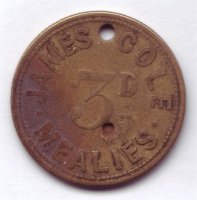 |
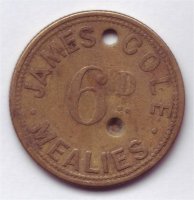 |
ex Milner Snell Collection |
- read on below |
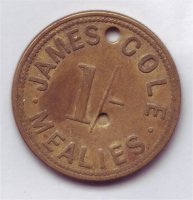 |
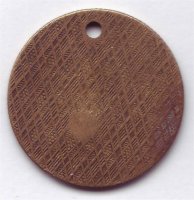 |
James Cole Matatiele token in the Balson Holdings Family Trust (punch to left of value)
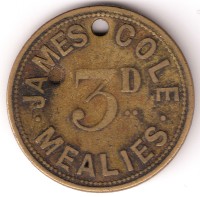
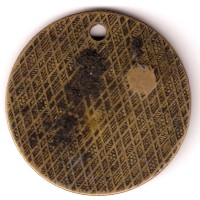
acquired on BidorBuy September 2008
Location of Cole's stores can be seen at this link. According to members of the Cole family the manager of the Standard Bank in Kokstad refused to extend James's overdraft and so he went off and had the tokens minted. More at this link.
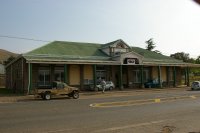 |
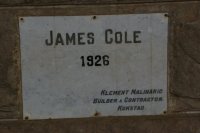 |
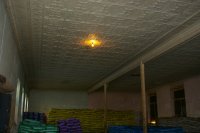 |
The beautiful stone building |
The plaque |
and its large storage capacity |
| Extract "Zulu Journey"
by Carel Birkby (pp 191-192) - from an interview with James Cole in
1937
The fiery days passed and Jim Cole prospered. Eventually, he even issued his own "currency". The Cole "coinage" consisted of brass discs, patterned on the reverse and bearing on the obverse "James Cole - 1s - Mealies". I have four Jim Cole coins, which are a rarity now. Three of them are "mealie coins" as is shown by the fact they have one hole drilled through them. The fourth has two holes drilled in it which signifies that it was an "oats" coin. When Jim Cole bought the natives' produce he paid them in these tokens, which he intended should be tender for goods bought at his trading stores. He paid his "boys" their wages in these brass coins also. Soon, however, "Cole currency" became practically common tender in East Griqualand. The natives trusted the great "Ujim", and so they used his coins as freely as they used Queen Victoria's - more freely, in fact, since in those early days real cash was scarce in East Griqualand. Until 18 months ago (1935) the "Cole coins" still circulated in some parts of the country, but now the police have put their foot down and insisted that the currency of only one king may be used in the realm. |
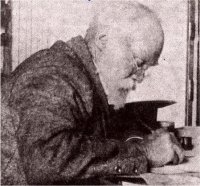 The
coins were colloquially referred to as "Ujim's money" by the natives.
Rumour has it that the trade tokens were hidden by the eccentric James Cole
in case they could be used again one day, like Kruger's gold the question
is where?
The
coins were colloquially referred to as "Ujim's money" by the natives.
Rumour has it that the trade tokens were hidden by the eccentric James Cole
in case they could be used again one day, like Kruger's gold the question
is where?
Image right: James Cole, the "Scrooge" of Nomansland, working in his Riverside store
James Cole, born in 1842, arrived in Durban in 1860 on the boat Oaks and first settled in Greytown before he moved to Nomansland. According to his great granddaughter Cole had to leave England because he was involved in cattle rustling.
James and his brother William battled to make ends meet at Donnybrook (near Ixopo in southern Natal) in the 1860s where they were illegally felling yellowwood trees. In 1869 they devised a plan to start a business with the proceeds of a reward of £50 offered by the government for anyone providing information that led to the conviction of anyone stealing timber from reserved forests. On the spin of a coin William became the informant and reported illegal tree felling by his brother James who was, as a result, imprisoned. William claimed the reward but instead of keeping it until James was released he spent it. According to the family the two brothers never spoke to each other again - but it was James, the convict, who would later become incredibly rich.
Before this James worked as a farm manager for Cecil Rhodes on a cotton farm near Ixopo. Cecil joined him towards the end of 1870 as a young man of seventeen when he first came to South Africa. In 1871 Rhodes left for the diamond fields of Kimberley and James moved to Creighton (up the Umzimkulu River) where he started his empire with just six acres and two cows taking Rhodes' extensive library of books which he pilfered after Rhodes had left. His theft was discovered by accident many years later by Canon Horace Norton at James' Riverside farm in East Griqualand shortly after Rhodes' death in 1902. Sprung - Cole had no escape so the books were boxed and returned to Somerset House.
It was in 1871 that James Cole first started bartering with the local Africans exchanging beads, trinkets, tinder-boxes, blankets, cloth, needles, thread, hoes, horses and guns for cattle hides, skins and timber. Once he had accumulated enough cattle hides and timber he would take them by oxwagon and sell them to merchants in Pietermaritzburg. It was during one of these trips that he met his wife, Sarah Ann Lily Houston, a farmer's daughter - marrying her in 1872.
That year they bought the farm Riverside measuring 3,000 acres. They had just two ox wagons, two teams of oxen, seventeen head of cattle and five horses. They continued to trade with the natives opening their first store and butchery at Riverside in 1873. They had several children - but many died in infancy.
Interestingly, Cole's eldest daughter, Kitty, married Donald Strachan's son Robert in 1898 - so two great trading empires were joined by marriage. It could well be that Robert Strachan, who later became Chairman of the new Strachan and Co Company was the catalyst for the James Cole trade tokens.
James and Lily Cole built an empire which soon included eighteen trading stores across southern Natal, East Griqualand and Lesotho. He also started buying up large tracts of land and eventually employed eighteen farm managers to run his farms which extended over 250,000 acres across East Griqualand, the Orange Free State and Zululand at the time of his death in 1937.
James Cole's favourite trick was catching out the sales reps. On the days the reps called he would sit on an old log near the gate to his Riverside store in tatty clothes with an unkempt appearance with days of growth on his face. The manner in which James Cole dealt with the reps who called depended on how they treated "the apparent tramp". Woe betide the rep who tried to belittle him before entering the store.... moments later after asking for "James Cole" they would be directed back to the "tramp" by the staff inside.
James Cole (known by the natives as Ujim) was a reclusive, eccentric and notoriously Scrooge-like millionaire who owned 18 farms and 18 native trading stores. The story is told of a member of his staff at the Riverside store buying 2lb of screws then dropping them one by one from the door of the store, in the path, across the grass and a large paddock. He then watched from a secret place as James Cole spent many hours following the trail of screws looking for them - satisfying his obsession to prevent waste or financial loss no matter how small. He was said to have collected tufts of sheep's wool caught on barbed wire fences and to keep count of matches in each box in his stores. His grandchildren would tease the old man by dropping a nail between his office and the station knowing that he would stop to pick it up. James was renowned for working extremely long hours and ran his trading empire until his death in 1937 at the age of 96.
James Cole stirred many emotions in people. He was not well liked. He was known as "Rockefeller of Riverside", the "Laird of Franklin", "Old King Cole" and "Ujim" by the natives.
Margaret Rainer's book, "MADONELA DONALD STRACHAN: AUTOCRAT OF UMZIMKULU" records how James Cole mercilessly pursued and then sued his brother-in-law over a small unpaid debt of £16.2.0 for goods purchased from his store - it was the Magistrate at Umzimkulu, Donald Strachan, who heard the evidence - the outcome is not known.
Milner Snell's book "Old King Cole, James Cole of Riverside" gives the most indepth history of this interesting man.
Major Hook in his book "Sword and Statute" reflects on the miser's wealth with "quite a principality; milking sixty cows; thoroughbred horses, imported mixed with kaffir stock, miles and miles of farms along a shining river".
When James Cole died in 1937, five years after Lily had died, he left an estate of 54 farms, 52 erven, property in Durban, Village of Franklin, 12.013 head of cattle, 22,992 sheep and eighteen stores valued at £419,390-10-0. (James Cole's eldest daughter Kate married Donald Strachan's son Robert.)
Footnote:
It was rumoured that James Cole hid his tokens under the floor of the butchery
at Riverside when he had to withdraw the coins. Milner Snell of the Kokstad
Museum reported the following in July 2006: The
butchery at Riverside does still exist although it is in a bad state. Underneath
the building is cellar where the meat was stored. The floor is dirt. I arranged
a metal detector and did a quick sweep of the butchery, but alas I came across
bits of metal but no tokens. This can lead to three conclusions: My
source was wrong, the tokens are buried deeper than the detector I had could
reach or that they were washed away in a very bad flood that went through
Riverside in the 1980s. Riverside was once a very attractive but rather run
down settlement. Unfortunately over the last two years a large low cost housing
scheme has been built close to the old hotel and it has ruined it.
More on James Cole at this link, see also comments by Major Hook
 Milner Snell's tribute to the
James Cole tokens (Milner Snell seen right):
Milner Snell's tribute to the
James Cole tokens (Milner Snell seen right):
Tokens of the realm
Pockmarked pieces of metal
minted by the king
knotted in handkerchiefs
and strung on string
spent in stores
dusty and dark
when the wool has been sheared
and the mealies are ripe.
 W W
Phillips
W W
Phillips
(Extremely Rare (Fuld) Rarity Scale: R - 8).
Not much is known about these tokens which are struck in galvanised iron.
Phillips had two trading stores, one at Lurwayizo and the other at Mendu.
In 1928 the store at Mendu was transferred from WW Phillips to LGO Phillips. In 1932 LGO Phillips sold the store to Victor Tomes.
The pieces below in the Balson Holdings Family Trust collection represent both stores (ex Allyn Jacobs).
 |
 |
 |
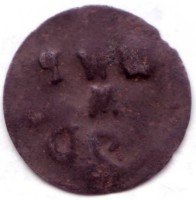 |
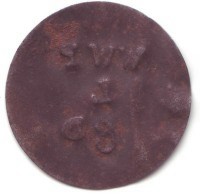 |
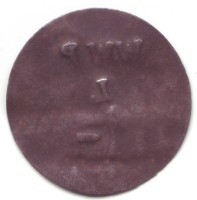 |
Mendu - 2d |
Lurwayizo (Lucwezo) - 6d |
Lurwayizo (Lucwezo) - 1/- |
These coins are conservatively valued at about US$700 each
F C Larkan (East Griqualand and
Natal)

Trading only - Extremely Rare (Fuld) Rarity Scale: R - 7).
This is the most famous and sought after set of trade tokens in South Africa after the Strachan and Co.
The Balson Holdings Family Trust holds eleven of the fifteen trade only sets of four tokens known to be in existence (see image below). None of these sets have been sold or traded since the 1980s. The three unholed 2/- are the only known that have not been defaced. The Balson Holdings Family Trust also holds about forty multi-purpose sets of the four F C Larkan tokens - these tokens are badly corroded after being in a field toilet (long drop) for over twenty years. Only one of these multi-purpose sets has been released - to well known South african numismatist, Allyn Jacobs.
The F C Larkan tokens have a rich and unique history and served a multiplicity of purpose over a fifty year period in the 1900s. Location of Mrs Larkan's stores can be seen at this link.
These coins are valued at about US$350 each
The Larkan labour tokens - Extremely Rare (Fuld) Rarity Scale: R - 7)
The RPL and NFL (Larkan) labour tokens pictured below are extremely rare with only one RPL piece being traded by the Balson Holdings Family Trust with South African numismatist and token coin specialist, Allyn Jacobs. The balance of these tokens are retained by the trust.
The entire Frances Charlotte Larkan story can be seen at this link.
(Very Scarce, Fuld rarity scale: R 4)
A letter from the company dated 1978 regarding this set of tokens can be seen at this link.
 |
 |
Staffords Trading Post - Rietvlei
(East Griqualand)
(Unique, Fuld rarity scale: R 10)
The unique Staffords Post Trading token owned by the Balson Holdings Family Trust displayed here:
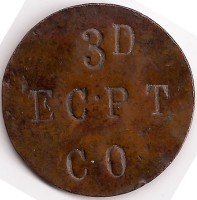
In October 2004 well known token coin collector Allyn Jacobs wrote an email to me in which he said “Now all I need is a Stafford”. He was referring to the elusive trading tokens issued by Charles Stafford in about the 1880s. Reverse of the Stafford's post 3d at this link
Charles Stafford’s English father, Edward, was one of the first traders to cater for the Griqua after their flight across the infamous Ongeluksnek in the late 1860s. He had a small trading store at their Mount Currie settlement and was one of the first two traders (the other Wildridge) who set up business in 1872 in the deserted village of Kokstad. Despite all efforts the Griqua remained at their cold Mount Currie settlement until Adam Kok III forced his people off the cold mountain slopes and down to Kokstad in 1874.
In the mid 1870s Stafford set up a remote but well positioned trading post on the main wagon road from Kokstad to Umzimkhulu in a region known as Rietvlei (the name remains today). The trading post did a flourishing trade with the natives and passing ox wagons.
Image right: Rietvlei in 2006. Scott Balson took this pic at Rietvlei while travelling to Kokstad
It was at Rietvlei that the notorious Smith Pommer and Griqua outlaw Muis Kok roamed the banks of the Ibisi River in the mid 1870s with their growing band of rebel followers. The outspoken Pommer had continuously been in conflict with the common sense approach of the Griqua Secretary, Brisley (of Strachan and Co fame) while Muis Kok was wanted by the Magistrate in Kokstad on a charge that would see him imprisoned. The two rebels led an aborted siege of Kokstad in 1878 with Rietvlei being the accepted place where the rebels hatched their plot. The turmoil following the Griqua uprising forever changed the face of East Griqualand with the new white arrivals losing trust in the Griqua who had traditionally been extremely loyal to the British Queen.
I was first alerted by Ken Strachan, the general manager of Strachan and Co in the 1970s, to the fact that Staffords Post had had token coins at about the time the first S&Co sets appeared. At the time I was doing research into the book “Kence, the trade tokens of Strachan and Co” and counting some 20,000 Strachan coins. Like the S&Co the Stafford tokens were issued because of the shortage of change. Ken described the brass tokens as being very rough with initials stamped into them like the tokens of W W Phillips used at Lurwayizo and Mendu. He had not seen any for many, many years and it was doubted that any remained.
Then I saw this innocuous looking 3d coin on South Africa's leading online auction house Bid or Buy. I secured the token for a few hundred rand while my maximum bid had another “0” behind the price I paid. The token fitted Ken’s description perfectly and the seller was located in Port St Johns – geographically close to the location of the original store.
I have no doubt that this token is an original Staffords Post trading token. It is in a very good condition for its age (see image below). It has the initials EG.PT Co (East Griqualand . Post Trading Company) and the value 3d stamped on one side. This is the only Stafford Trading Post token known.
Oldfield Brothers - Highflats
(southern Natal)
(Unique, Fuld rarity scale: R 10)
The unique Oldfield Token displayed here:
It is most likely that the token was issued for use at the store on Ivanhoe. Considering the problems faced by Thomas at Brooklands it is unlikely that he made use of tokens there. One presumes that if it had been used in the 1907 to 1909 period when the Oldfields were in partnership they would have put Oldfield Brothers on the token. It seems therefore that Henry Oldfield issued the token when he was trading by himself at Ivanhoe, some time after 1909
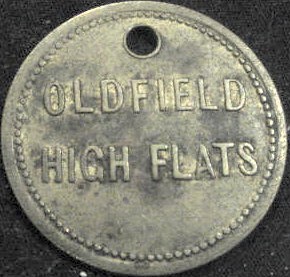 The Oldfield Brothers
The Oldfield Brothers
The brothers Henry William and Thomas Frederick Oldfield owned a trading store in the Ixopo district of Natal. The brothers hailed from Islington in Middlesex, where their father, Henry, worked as a publican. More is known of Henry’s earlier life than that of Thomas’s. Henry was born on 23 January 1873. On 11 March 1893, at the age of 21, he married the 18 year-old Amy Florence, daughter of Henry James Heapy at the Parish Church in Islington. Henry was described as a clerk at the time of his marriage. At the time of their marriage Henry lived at 29 Newington Road and Amy at 59 Newington Road. They must have grown up on the same street and could have been childhood sweethearts. Thomas arrived in Natal in 1901 and presumably Henry followed soon afterwards. In the 1906 Natal Directory Thomas is described as a member of the Natal Police stationed at St Faith’s. By the 1907 he is listed as a farmer of Highflats. Presumably he had left the police and taken up farming and trading. By 1909 Henry is listed in the directory as a storekeeper and farmer at Highflats. (He seems to have been at Highflats at least a year or two earlier). The brothers were in partnership in a trading store on the farm Ivanhoe. In 1908 the brothers decided to extend their trading operations and buy a store from H.A. Taylor at Brooklands. (Brooklands was near to St Faith’s). They had trouble raising capital and E.E. Dennis, another trader in the district, agreed to provide the finance on condition that the store and land be ceded to him. He agreed to in turn cede Brooklands to the brothers once they had paid him back.
On 10 August 1908 F.L. Thring, a solicitor of Ixopo, wrote to the Surveyor General on behalf of the Oldfields: Mr H.A. Taylor the purchaser of Brooklands Ixopo Division requests me to write and state that he is now making a start to erect a stone building on the land 41 x 15 feet and verandah all roofed with iron for a store and dwelling house…Mr Taylor further desires to know if you will approve of Messrs Oldfield Bros farmers and storekeepers occupying the land one of the brothers will permanently reside thereon. Messrs Oldfield Bros are a respectable firm of young European Britishers (English).
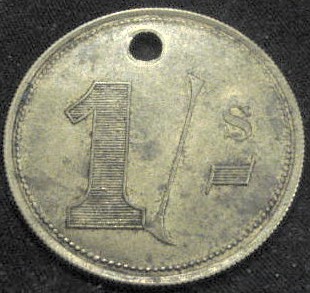 Thring again wrote to the Surveyor General on 17 September: Mr Taylor who resides in this village carrying on the business of a Butcher and Baker purchased the land at the last Government land sale with the then intention of residing thereon but as he subsequently acquired business here he gave up the idea. He now desires to sell the land to Mr W.H. Oldfield but Mr Oldfield having sunk most of his capital in store-keeping with his brother has not sufficient to purchase the land and carry out farming operations as he should like but he can borrow the necessary funds from Mr E.E. Dennis but only Mr Dennis declines to advance the money excepting on condition that the land is ceded to him as he does not like Bonds and an agreement would be drawn between Dennis and Oldfield re cession to Oldfield when he repays Dennis. This is a round about way of Mr Dennis holding security but it is the only way he will do it.
Thring again wrote to the Surveyor General on 17 September: Mr Taylor who resides in this village carrying on the business of a Butcher and Baker purchased the land at the last Government land sale with the then intention of residing thereon but as he subsequently acquired business here he gave up the idea. He now desires to sell the land to Mr W.H. Oldfield but Mr Oldfield having sunk most of his capital in store-keeping with his brother has not sufficient to purchase the land and carry out farming operations as he should like but he can borrow the necessary funds from Mr E.E. Dennis but only Mr Dennis declines to advance the money excepting on condition that the land is ceded to him as he does not like Bonds and an agreement would be drawn between Dennis and Oldfield re cession to Oldfield when he repays Dennis. This is a round about way of Mr Dennis holding security but it is the only way he will do it.
The Surveyor General agreed to the deal, however, shortly afterwards the brothers dissolved their partnership. Henry retained Ivanhoe and Thomas took over Brooklands. Thomas soon ran into trouble at Brooklands when he was refused a trading licence. In a detailed letter to the Colonial Secretary written from Brooklands on 9 March 1909 he complained that the licence had been refused as the Roystons, who owned the neighbouring store St Faith’s, had objected. (The Royston made use of tokens at St Faith’s See St Faith's token above). Thomas insisted that the magistrate declined the licence as he was a close friend to the Royston family. It is not clear if the issue was resolved but in 1911 Thomas was arrested for ‘falsity and theft’. According to the warrant of apprehension, upon or about 17 January 1910 Thomas ‘unlawfully, knowingly, designedly, fraudently, and falsely’ told a Chief named Bhekameva that he was the owner of Ivanhoe and borrowed £300 from the chief using Ivanhoe as collateral. The charge of theft occurred ‘at some time or times between the first day of July, in the Year of Our Lord One thousand Nine Hundred and Six, and the thirteenth day of April, in the Year of Our Lord One Thousand Nine Hundred and Nine’ when Thomas did ‘wrongfully and unlawfully steal moneys amounting to the sum of three hundred and sixty-eight pounds and fourteen shillings sterling, or there abouts, the property or in the lawful possession of Mate and Ntando, Natives’. On 22 July 1910 he was alleged to have stolen a further 28 pounds ten shillings and ten pence from mate and Ntando. It is not clear what the outcome of the trial was, but he disappears from the Natal Directory and one presumes he was living as a guest of His Majesty in the Pietermaritzburg gaol. E.E. Dennis took over Brooklands and was successful in obtaining a licence as he traded there until 1918 when he sold the store to Strachan & Co. (Dennis made use of tokens at Brooklands. See the chapter on Creighton & Dennis. Strachan & Co. also made use of tokens at the store).
Henry Oldfield farmed and traded at Ivanhoe until his death at the King Hospital in Ixopo on 5 July 1959. (Amy Oldfield had died in 1951). Henry died at the age of 86 years and 5 months. According to his death notice, his parents were living at 9 Grovelands Road, palmers Green, Holmleigh. One presumes this is where they had lived and were deceased unless they were both well over a hundred! Ivanhoe was inherited by Henry’s three sons: Percy, Reginald and Leonard.
Jagersfontein - Three
gallons
(Griqualand West)
Ref: 05 Tokens of S Africa and their History - Dr G P Theron
Scarce, (Fuld) Rarity Scale: R - 2)
The story behind the Jagersfontein three gallon token can be found hidden in the pages of the book "The Grand Old Days of the Diamond Fields". It has been included here because Jagersfontein is in the centre of the disputed area taken by the boers from the Griquas stationed in the Philippolis region. Jagersfontein, in the Orange Free State shire of Xhariep, was founded in the great diamond rush of the 1870s. The town is about six miles from Fauresmith and was once on the main route taken by fortune hunters on their way north to other diamond fields. Many of these speculators used to put up camp on the ground which later became the home of some of South Africa's biggest diamonds including the Excelsior weighing in at over 970 carats and the Jubilee (or Reitz) weighing in at 634 carats.
The land was owned by a farmer named Cornelius Johannes Visser. Not long after he died his widow hired an overseer, J J De Klerk, to tend to the farm. Perchance and on an intuition De Klerk started digging for diamonds on the property - his first find was a 50 carat stone... the word quickly got around and the speculators moved in and started digging there.
In 1888 the New Jagersfontein Exploration Company was incorporated and gradually absorbed the various interests. The New Jagersfontein Company, as it is known since the Boer war, is capitalized at £1,000,000, divided into 500,000 each of ordinary and deferred shares. The shape of the mine is a rough oval, and the size of it about 1,500 by 2,000 feet, and it contains 1,124 claims. It has been skillfully and methodically worked as an open mine to depths, which in all the others entailed most disastrous consequences. It is worked down in concentric terraces. The three lowest are carried down 360, 410 and 450 feet, with a small area below, 480 feet deep, and late reports claim that a depth of 700 feet in the open has been reached. So well has this been done that the system serves as a model to mines discovered later, in their open working.
At the beginning of the Boer war, this mine had been producing about 250,000 carats yearly. In 1898, 232,-433 carats; in 1899, 288,937 carats. In 1900 the production fell to 183,399 carats, and in 1901, while the war was on, to 18,002 carats. Work was then abandoned until July, 1902, when the English company again took possession of the mine. Some months were occupied in getting the water out of the mine, repairing and re-placing machinery, etc. ; after which, work was resumed and 29,302 carats won for the year ending March 31, 1903.
As the land and growing township was far from any reliable source of water the local authority, the Jagersfontein Municipality, started drawing water from the creeks some distance away for resale at the mine and in the township. In 1913 the the Municipality had 10,000 of these "three gallon" disks made in Birmingham, to facilitate the purchase of water from the central water pumps. The disk was pressed into a slot, a lever pulled and out came 3 Gallons of water hence the name Water Penny.
There is still trouble over water in Jagersfontein today with the town water having unacceptable levels of arsenic resulting from earlier mining activities.
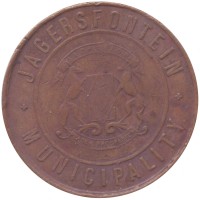 |
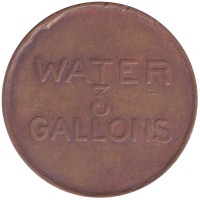 |
These coins are valued at about US$15 each
More on the Griquas and Diamonds at this link.